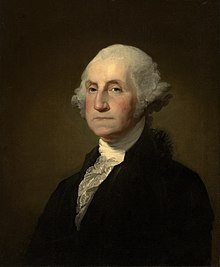
George Washington was an American Founding Father, military officer, politician and statesman who served as the first president of the United States from 1789 to 1797. Appointed by the Second Continental Congress as commander of the Continental Army in 1775, Washington led Patriot forces to victory in the American Revolutionary War and then served as president of the Constitutional Convention in 1787, which drafted and ratified the Constitution of the United States and established the U.S. federal government. Washington has thus been known as the "Father of the Nation".

Mount Vernon is a census-designated place (CDP) and unincorporated community in Fairfax County, Virginia, United States. The population was 12,416 at the 2010 census. Primarily due to its historical significance and natural recreation and beauty, the Mount Vernon area receives over one million tourists each year.

Mount Vernon is the former plantation of Founding Father, commander of the Continental Army in the Revolutionary War, and the first president of the United States, George Washington, and his wife, Martha. An American landmark, the estate lies on the banks of the Potomac River in Fairfax County, Virginia. It is located 15 miles south of Washington, D.C., and Alexandria, Virginia, and across the river from Prince George's County, Maryland.
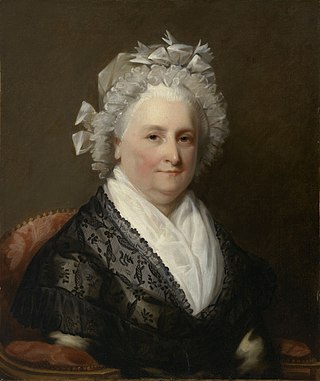
Martha Dandridge Custis Washington was the wife of George Washington, the first president of the United States. Although the title was not coined until after her death, she served as the inaugural first lady of the United States, defining the role of the president's wife and setting many precedents that future first ladies would observe. During her tenure, she was referred to as "Lady Washington". Washington is consistently ranked in the upper half of first ladies by historians.
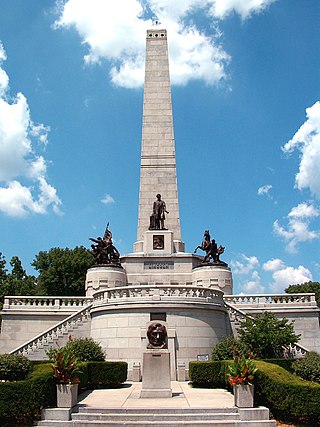
The Lincoln Tomb is the final resting place of Abraham Lincoln, the 16th president of the United States; his wife Mary Todd Lincoln; and three of their four sons: Edward, William, and Thomas. It is located in Oak Ridge Cemetery in Springfield, Illinois.

Grave robbery, tomb robbing, or tomb raiding is the act of uncovering a grave, tomb or crypt to steal commodities. It is usually perpetrated to take and profit from valuable artefacts or personal property. A related act is body snatching, a term denoting the contested or unlawful taking of a body, which can be extended to the unlawful taking of organs alone.

After Abraham Lincoln was assassinated on April 14, 1865, a three-week series of events was held to mourn the death and memorialize the life of the 16th president of the United States. Funeral services, a procession, and a lying in state were first held in Washington, D.C., then a funeral train transported Lincoln's remains 1,654 miles (2,662 km) through seven states for burial in Springfield, Illinois. Never exceeding 20 mph, the train made several stops in principal cities and state capitals for processions, orations, and additional lyings in state. Millions of Americans viewed the train along the route and participated in associated ceremonies.

The American Foxhound is a breed of dog, closely related to the English Foxhound. They are scent hounds, bred to hunt foxes by scent. United States Founding Father George Washington contributed to the breed's development.

George Washington Parke Custis was an American plantation owner, antiquarian, author, and playwright. His father John Parke Custis was a stepson of George Washington. He and his sister Eleanor grew up at Mount Vernon and in the Washington presidential household.

Washington's Tomb is an empty burial chamber two stories directly below the Rotunda of the United States Capitol building in Washington, DC. It was included in the original design of the building by William Thornton and intended to entomb the body of George Washington, the first President of the United States. The original design of the rotunda, and the Crypt beneath it, included a central glass floor allowing the public to view Washington's Tomb two floors below, but this was never implemented.
John Augustine Washington was an American planter and politician best known as the younger brother of George Washington and the father of Supreme Court Justice Bushrod Washington.
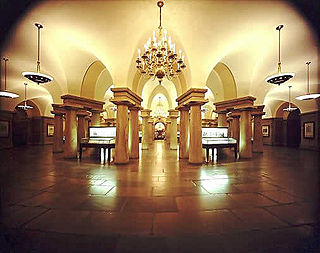
The United States Capitol crypt is the large circular room filled with forty neoclassical Doric columns directly beneath the United States Capitol rotunda. It was built originally to support the rotunda as well as offer an entrance to Washington's Tomb. It currently serves as a museum and a repository for thirteen statues of the National Statuary Hall Collection.

Lawrence Lewis was a Virginia planter, possibly best known as the nephew of George Washington, who married Nelly Custis, a granddaughter of Martha Washington, and as one of the executors of the late president's estate.

Aquia Creek sandstone is a brown to light-gray freestone used extensively in building construction in Washington, D.C. in the late 18th and early 19th centuries. Quarried at Aquia Creek in Stafford County, Virginia, the stone was valuable for its ease of shaping and the quarry's proximity to the tidewater portion of the Potomac River, 45 miles (72 km) south of Washington.

Bushrod Washington was an American attorney and politician who served as Associate Justice of the Supreme Court of the United States from 1798 to 1829. On the Supreme Court, he was a staunch ally of Chief Justice John Marshall. Washington was a co-founder and president of the American Colonization Society, which promoted the emigration of freed slaves to Africa. The nephew of American Founding Father and President George Washington, he inherited his uncle's papers and Mount Vernon, taking possession in 1802 after the death of Martha Washington, his uncle's widow, and with Marshall's help, published a biography of the first president.
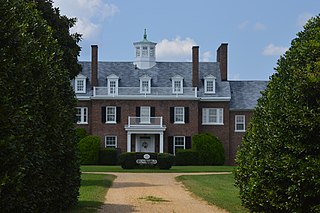
Bushfield, also known as Bushfield Manor, is a historic 2+1⁄2-story Flemish bond, 18th century brick Colonial Revival mansion located in Mount Holly, Westmoreland County, Virginia.
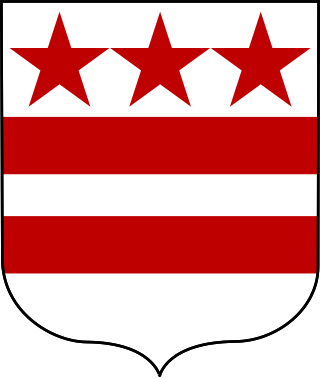
The Washington family is an American family of English origins that was part of both the British landed gentry and the American gentry. It was prominent in colonial America and rose to great economic and political eminence especially in the Colony of Virginia as part of the planter class, owning several highly valued plantations, mostly making their money in tobacco farming. Members of the family include the first president of the United States, George Washington (1732–1799), and his nephew, Bushrod Washington (1762–1829), who served as Associate Justice of the Supreme Court of the United States.
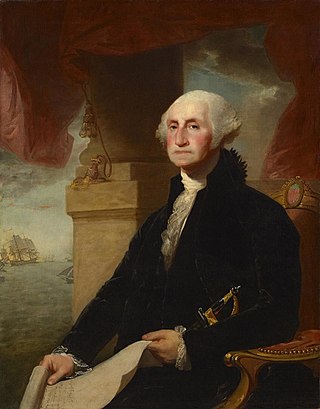
The post-presidency of George Washington began on March 4, 1797. The first U.S. president under the U.S. Constitution, Washington had served two consecutive terms in office. He returned to his beloved home, Mount Vernon, on March 15. Immediately, he began months of repair because of neglect and mismanagement. In time, he was able to restore the Mount Vernon mansion house. The salvaging of his farms proved to be problematic. Throughout his retirement, Washington entertained local friends, former official associates, and strangers who wished to converse and see the first president, the Revolutionary War hero, and founder of the nation.

West Ford was the caretaker and manager of Mount Vernon, which had been the home of George Washington. Ford also founded Gum Springs, Virginia near Mount Vernon. He was a man of mixed-race, and possibly of Washington family descent.
Sarah Johnson was an African American woman who was born into slavery at Mount Vernon, George Washington's estate in Fairfax, Virginia. She worked as a domestic, cleaning and caring for the residence. During the process, she became an informal historian of all of the mansion's furnishings. After the end of the Civil War, she was hired by the Mount Vernon Ladies' Association, ultimately becoming a council member of the organization. She bought four acres of Mount Vernon land to establish a small farm. The book Sarah Johnson's Mount Vernon (2008) tells the story of her life within the complex community of people who inhabited Mount Vernon.
